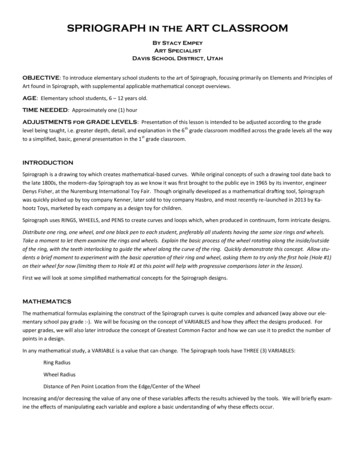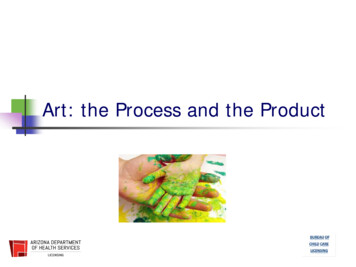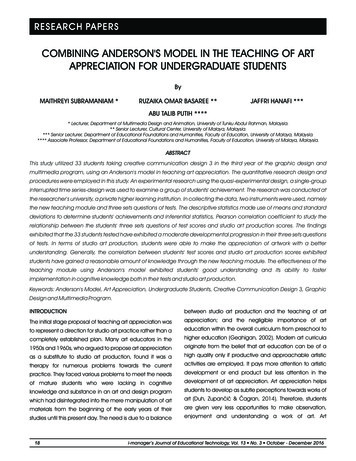
Transcription
SPRIOGRAPH in the ART CLASSROOMBy Stacy EmpeyArt SpecialistDavis School District, UtahOBJECTIVE: To introduce elementary school students to the art of Spirograph, focusing primarily on Elements and Principles ofArt found in Spirograph, with supplemental applicable mathematical concept overviews.AGE: Elementary school students, 6 – 12 years old.TIME NEEDED: Approximately one (1) hourADJUSTMENTS for GRADE LEVELS: Presentation of this lesson is intended to be adjusted according to the gradelevel being taught, i.e. greater depth, detail, and explanation in the 6 th grade classroom modified across the grade levels all the wayto a simplified, basic, general presentation in the 1st grade classroom.INTRODUCTIONSpirograph is a drawing toy which creates mathematical-based curves. While original concepts of such a drawing tool date back tothe late 1800s, the modern-day Spirograph toy as we know it was first brought to the public eye in 1965 by its inventor, engineerDenys Fisher, at the Nuremburg International Toy Fair. Though originally developed as a mathematical drafting tool, Spirographwas quickly picked up by toy company Kenner, later sold to toy company Hasbro, and most recently re-launched in 2013 by Kahootz Toys, marketed by each company as a design toy for children.Spirograph uses RINGS, WHEELS, and PENS to create curves and loops which, when produced in continuum, form intricate designs.Distribute one ring, one wheel, and one black pen to each student, preferably all students having the same size rings and wheels.Take a moment to let them examine the rings and wheels. Explain the basic process of the wheel rotating along the inside/outsideof the ring, with the teeth interlocking to guide the wheel along the curve of the ring. Quickly demonstrate this concept. Allow students a brief moment to experiment with the basic operation of their ring and wheel, asking them to try only the first hole (Hole #1)on their wheel for now (limiting them to Hole #1 at this point will help with progressive comparisons later in the lesson).First we will look at some simplified mathematical concepts for the Spirograph designs.MATHEMATICSThe mathematical formulas explaining the construct of the Spirograph curves is quite complex and advanced (way above our elementary school pay grade :-). We will be focusing on the concept of VARIABLES and how they affect the designs produced. Forupper grades, we will also later introduce the concept of Greatest Common Factor and how we can use it to predict the number ofpoints in a design.In any mathematical study, a VARIABLE is a value that can change. The Spirograph tools have THREE (3) VARIABLES:Ring RadiusWheel RadiusDistance of Pen Point Location from the Edge/Center of the WheelIncreasing and/or decreasing the value of any one of these variables affects the results achieved by the tools. We will briefly examine the effects of manipulating each variable and explore a basic understanding of why these effects occur.
Ring RadiusThe radius of a circle is the distance from the center of the circle to any point on the circle. The circumference of a circle is the linear distance around the edge of the circle (if we took the line making the circle, made it straight, and measured it, that measurement would be the circumference).When the radius of the Spirograph RING increases or decreases, it changes the circumference of the ring and the number of teethon the ring. When the ring radius increases, the number of teeth on the ring increases. A wheel travelling along the ring must thencover a greater distance to return to its start point on the ring. Because the number of teeth on the wheel does not increase, thenumber of wheel rotations must increase in order to cover the increased distance caused by the increased radius of the ring.Changing the ring radius causes a shift to the curves and changes the number of points in the resulting design (see figure 1).*** PLEASE NOTE: Designs using different ring sizes are also available in the manual included in Spirograph sets. The figures included in this lesson plan place these designs side-by-side, for ease of student comparison. ***If you have enough rings in two sizes for all of your students, distribute the second size rings to each student and give them a moment to briefly experiment with the second ring and the original wheel, again using only Hole #1, and comparing the results theyachieve between their two designs. Otherwise, display the included figure comparisons for the class or provide a quick demo usingtwo different size rings.Wheel RadiusAgain re-emphasize the definition of the radius and circumference of a circle.When the radius of the Spirograph WHEEL increases or decreases, it changes the circumference of the wheel and the number ofteeth on the wheel. When the wheel radius increases, the number of teeth on the wheel increases. A larger wheel travelling alongthe ring covers the distance using less of its circumference before it returns to its start point on the ring. Because the number ofteeth on the ring does not change, the number of wheel rotations required to cover the ring’s distance decreases (i.e. the biggerthe wheel, the greater its circumference, the greater the distance it covers on the ring in a single rotation, the fewer rotations itneeds to return to the start point on the ring). In this regard, the change in the radius of the wheel changes the number of pointsin the resulting design.Changing the radius of the wheel also changes the range possibility for the distance the curves can reach from the ring. Thiseffect can be seen in two ways. FIRST: The smaller the radius of the wheel, the shorter the distance of the possible reach of thedesign from the ring. The larger the radius of the wheel, the longer the distance of the possible reach of the design from the ring.For example, if a wheel has a radius of ½ inch, the maximum distance from the ring that it can create curves is almost 1 inch [thefull diameter of the wheel, when the pen is placed in hole # 1] as the wheel moves around the ring and the pen alternately movescloser to and farther from the ring. Alternatively, if a wheel has a radius of 1 inch, the maximum distance from the ring that it cancreate curves is almost 2 inches [again, the full diameter of the wheel, when the pen is placed in hole #1]). SECOND: The larger thewheel, the further its reach to create a design with an overall smaller diameter (or in other words, the closer the outer edge of thedesign can get to the center of the ring). This effect is seen when using the hole of a wheel most near the center of the wheel. Forexample, using a wheel with a ½ inch radius and using a pen in the center-most hole results in a design whose minimum distancefrom the ring is close to ½ inch. Using a wheel with a 1 inch radius and using a pen in the center-most hole results in a designwhose minimum distance from the ring is close to 1 inch. (See Figure 2, which demonstrates this, sampling wheels of various radii,using the center-most hole of each, overlaid on each other to show the variation in distance achieved from the ring).Distribute a second wheel to each student (these can be a variety of sizes). Have the students again create a design using Hole #1on the new wheel. Then have the students create a design using the hole on each of their wheels which is most near the center ofeach wheel. Have the students compare the shape of the curves and the distance the curves travel from the ring in each of theirdesigns. For now, limit their designs to Hole #1 and the center-most hole on their wheels.
Location of Pen Point within WheelEach wheel has a number of holes wherein the pen may be placed to create the design. These holes provide opportunity to locatethe pen various distances from the edge/center of the wheel. Varying the pen point’s distance from the edge/center of the wheelalters the depth of the arcs (curves) created in the design (though noticeably does not affect the number of points in the design).As the pen point moves closer to the center of the wheel, the arcs created increase in depth. They may be described as becoming“more rounded.” (See Figure 3, which uses various wheels to overlay arcs created by various holes on the wheels [wheel sizes andhole numbers are labelled for each arc]. See Figures 4 – 9 for completed designs in various holes, with the arc sample placed alongside for comparison).Allow students to experiment with the various holes of their wheels. Then allow them to exchange their wheels for different sizesand experiment with the various holes of multiple wheel sizes. Additionally, allow them to use multiple colors of pens. They cancontinue to experiment silently as you introduce the art concepts of the lesson. As you progressively present the following art concepts, invite the students to specifically explore each concept in their experimentation.ART CONCEPTSWhen studying our Elements and Principles of Art, we are reminded that the Elements of Art are the building blocks of art (like theLegos) and that the Principles of Art are the ways in which the Elements are put together (like the instructions included in the Legoset). The following are applicable in our artistic study of Spirograph.Principle of Art: BALANCE (Radial or Rotational Symmetry)Balance (in art) is the way in which the elements in the art piece are laid out, arranged, or distributed in relation to each other and/or in relation to the artwork as a whole. Symmetry falls under the umbrella of balance. When something is symmetrical, it is exactly the same across a line/plane or around a point. These two types of symmetry are called bilateral (or reflective, meaning symmetrical across a line/plane of symmetry) and radial (or rotational, meaning symmetrical around a point or central axis). We seeexamples of both types of symmetry in nature and in man-made objects.Have the students offer examples of the types of symmetry they see, both bilateral and radial, both natural and man-made. Listthese by classification on the whiteboard/doc cam. See the sample below:Bilateral (Reflective) SymmetryRadial (Rotational) SymmetryIn NatureMan-MadeIn NatureMan-Madebutterflycars (exterior)starfishcar wheelsleavesbinocularsspider akflowerspinwheelsjellyfishAll objects which are radially symmetrical are also bilaterally symmetrical, however not all objects that are bilaterally symmetricalare radially symmetrical.Spirograph designs created on circular rings are both radially and bilaterally symmetrical.Have students lay down their pens and pause a moment from creating designs. Have them take this opportunity to consider andexamine their work and evaluate the radial (rotational) symmetry of their designs.QUESTION FOR DISCUSSION: How do you think the symmetry of these designs affects how the viewer feels about this art? What
impact does the symmetry of Spirograph designs have on how people respond to the designs? (Discussion may lead to pointing outthe general tendency/attraction of humans toward things which are balanced/symmetrical, an argument which can easily be supported with evidence found in civilizations throughout history.)Principle of Art: PATTERNPattern (in art) is the random or calculated repetition of art elements.The very nature of the Spirograph design creates pattern – the continuous repetition of curves to create intricate design. One penplaced within a single hole of a single wheel rotated within a single ring to complete a single design alone presents a complexity ofpattern. This, however, is only the beginning of the study of pattern that Spirograph can offer.Even more complex patterns can be created by repeating single patterns within the same design space, overlaying these designsresulting in eye-stunning patterns. This can be approached in a variety of ways. First, various holes within a wheel can be usedwithin the same design, creating layers of design with the same number of points, but with different arc depths (as discussed previously in this lesson). Secondly, using the same hole with the same wheel while off-setting the teeth of the wheel along the teeth ofthe ring will result in a pattern of the same design incrementally rotationally off-set from the original design. This approach (as wellas any other) can be combined with the use of patterns in color choice to increase the complexity of the pattern presentation (seeFigure 10 for two simple examples of this concept). Additionally, various wheels can be used within the same design space. Lastly,any combination of these three approaches will result in an infinite number of creative intricate patterns limited only by your imagination to put them together!Element of Art: SPACE (Adding Perspective through Layering and Color Gradation)Space (in art) is the area within the art designated for particular purposes, to include the distances or areas around, between, andwithin all things in the artwork. This also encompasses the creation of depth in art, also called perspective, which is simplisticallydefined as 3-D on a 2-D surface (artwork which appears 3-dimensional because of perceived depth, even though the artwork iscreated on a 2-dimensional surface).We can take the concepts of pattern presented above one step further to create a sense of perspective in our Spirograph designs.This is achieved by layering designs and colors in patterns that specifically foster the perception of depth. (See Figure 11 for simpleexamples of this concept – the technique employed in these samples is explained below, though other processes may be followedto achieve these results.)COLOR: In art, using cooler softer colors/tints can create a sense of depth for objects in the background of an artistic layout, making the eye think that those objects are fading into the distance. For example, a mountain range in the background of a paintingcan be created in softer lighter cooler hazier colors (grays, blues, greens) while the objects in the foreground are painted in stronger brighter warmer shades, lending to a sense of depth in the painting. Layer pen color in this way to produce this effect: darker/warmer colors for the smaller diameter designs layered over larger diameter designs produced with lighter/cooler colors that givethe sense of fading into the distance.WHEEL POSITION: To create a layered effect with a sense of depth in the design, use multiple holes in the same wheel to createdesigns that overlay each other by starting each new design in the same position on the ring. This is done by lining up the first holeto be used on the wheel with a specific hole on the ring (the holes on the wheels and rings have mark lines that extend to the edgeof the wheel/ring for this purpose). Draw the entire design that for that hole. Next, rotate the wheel so that the next hole youwant to use on the wheel is lined up with the same hole on the ring that was used for the start point of the first design. Draw thesecond design. Rotate the wheel again so that the next hole you want to use on the wheel lines up with the same hole on the ring.Continue in this manner for as many layers as you want. (The samples in this lesson use the odd number holes in the wheel: 1, 3, 5,7, etc.)
BONUS MATH INSTRUCTION (for 5th and 6th grade classes)A common mathematical concept that can be applied to Spirograph designs is the use of Greatest Common Factor (GCF) of twonumbers. You can calculate the number of points that will be produced in a design if you know the number of teeth on the ring,the number of teeth on the wheel, and use the following formula:Number of teeth on the ringDIVIDED BYThe GCF of the # of teeth on the ring and # of teeth on the wheelEQUALSThe number of points in the designEXAMPLE #1: We will use a ring that has 96 teeth and a wheel that has 50 teeth. The GCF of 96 and 50 is 2. Inserting these valuesinto the formula, we have:96 divided by 2 equals 48or96 / 2 48Therefore a design created with this wheel and this ring will have 48 points.EXAMPLE #2: We will use a ring that has 105 teeth and a wheel that has 60 teeth. The GCF of 105 and 60 is 15. Inserting thesevalues into the formula, we have:105 divided by 15 equals 7or105 / 15 7Therefore a design created with this wheel and this ring will have 7 points.CONCLUSIONEvaluate the designs the students have created. Summarize the concepts of the Spirograph variables. Re-emphasize the Elementsand Principles of Art discussed in the lesson. Allow students to share their designs with each other and discuss which designs theylike best and why.
FIGURE 1FIGURE 2
FIGURE 3
FIGURE 5FIGURE 4
FIGURE 6
FIGURE 7
FIGURE 8
FIGURE 9
FIGURE 10FIGURE 11
leaves binoculars spider web umbrella. animals bicycle snowflakes domes. insects kayak flowers pinwheels. jellyfish. All objects which are radially symmetrical are also bilaterally symmetrical, however not all objects that are bilaterally symmetrical are radially symmetrical.










